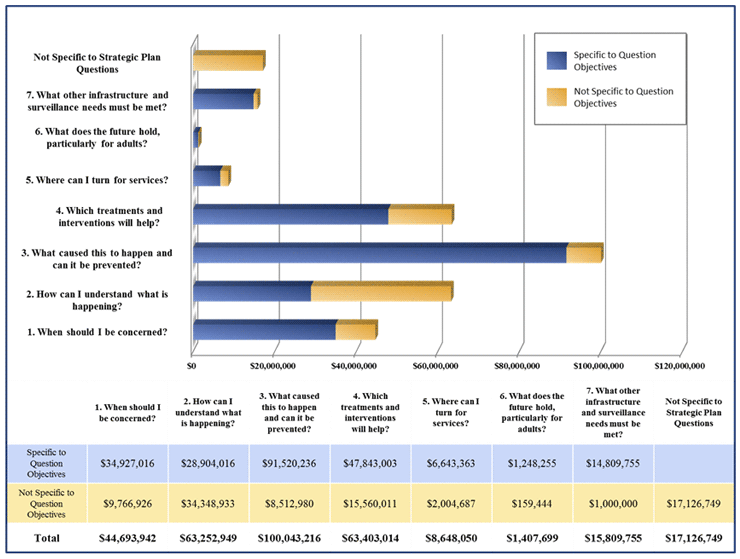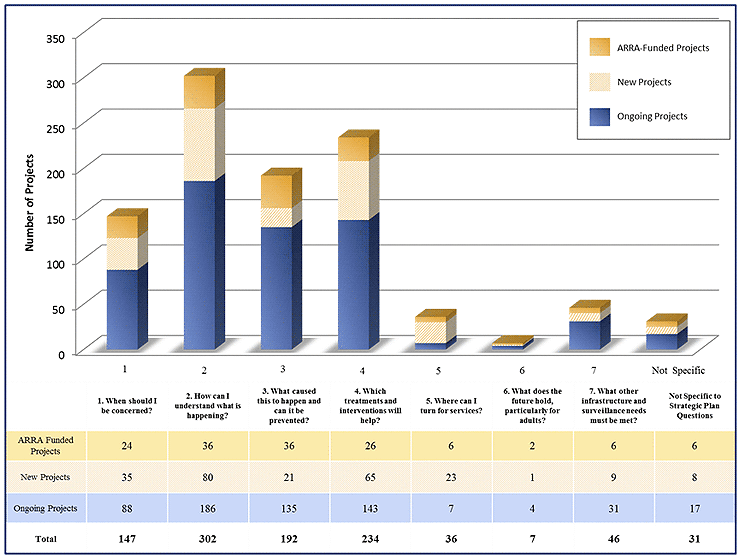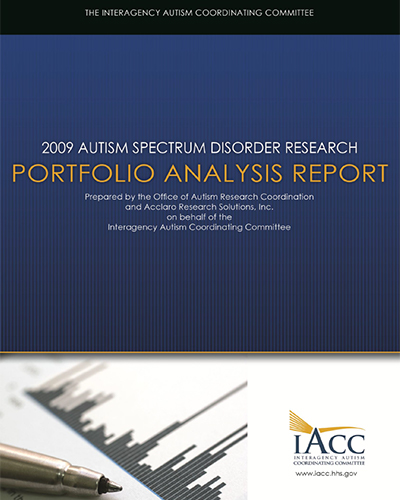Portfolio Analysis Report
IACC Autism Spectrum Disorder Research
2009
Within the seven questions that serve as the framework for the IACC Strategic Plan, each question has several specific short- and long-term objectives. In total, there are 62 objectives in the 2010 Strategic Plan. The objectives call for specific research efforts with a goal date for completion and include an estimate of the budget required to accomplish the goal.1 Each ASD project that received funding in 2009 was evaluated to determine which question and objective it fulfilled. This enabled assessment of progress corresponding to the Strategic Plan and identification of gaps in funded research.
Of the seven critical questions described in the 2010 Strategic Plan, Question 3 (risk factors), Question 6 (issues over the lifespan), and Question 7 (infrastructure and surveillance) had the largest percent of projects that were specific to Strategic Plan objectives (91%, 89%, and 94% respectively). Approximately 75% of the research encompassed by Question 1 (diagnosis), Question 4 (interventions and treatments), and Question 5 (services) is related to specific objectives in the Strategic Plan. Conversely, only 46% of funding allocated to Question 2 (biology of ASD) addressed Strategic Plan objectives (Figure 6). Brief descriptions of the types of projects that are not specific to particular objectives within a question are provided in the summary section for each question. The research projects specific to objectives combined with the projects falling outside the objectives represent the full scope of research being conducted for each question.
Within each question, the objectives are set apart by designating them as short- or long-term (with an "S" or an "L"), followed by sequential letters of the alphabet (e.g., 2.S.A, 2.S.B, 2.L.A, 2.L.B). For clarity of discussion, these shorthand abbreviations will be used in this analysis. For example, the first short-term objective in Question 1 ("When Should I Be Concerned?") is referred to as 1.S.A. Full titles and funding information for each objective can be found in Appendix A. The following analysis assesses the funding distributed to each question and its related objectives in the Strategic Plan (Figure 6).
2009 ASD Funding: Alignment with IACC Strategic Plan Objectives

Figure 6. 2009 ASD funding for each of the 2010 IACC Strategic Plan questions based on research specific to or not specific to question objectives. Funding specific to research objectives is designated in blue, while funding not specific to objectives is designated in yellow.
Question 1: When Should I Be Concerned?
Fourteen percent ($44,693,942) of 2009 total ASD funding, including 14% ($8,828,947) of NIH‑ARRA funding, corresponded to Question 1. Of that research, 78% ($34,927,016) was specific to the seven objectives within the question (Figure 6). The two objectives receiving the most funding relate to the development of biomarkers for ASD (1.L.A, 37%) and measures that would allow identification of subtypes across the spectrum (1.L.B, 20%). The two new objectives for this question received the least funding, addressing health disparities in ASD screening (1.S.C < 1%) and the impact of early diagnosis on choice of intervention (1.S.D, 0%). Twenty-two percent ($9,766,926) of ASD funding for Question 1 was not specific to any of the seven objectives (Figure 6) and consisted largely of general studies on early brain development and broad understanding of cognitive, behavioral, and social characteristics of autism that relate to early development, including development of social behavior and language skills. Of the 147 overall projects related to Question 1, 40% of the projects and 46% of funding ($20,713,264) were new in 2009.
Question 2: How Can I Understand What Is Happening?
Question 2 addresses the underlying biological pathways of ASD and includes seven short-term and two long‑term objectives. Research topics associated with Question 2 received the third largest investment, with 20% ($63,252,949) of the 2009 ASD research funding, including 19% ($12,072,609) of NIH-ARRA funding. Fourteen percent ($9,171,542) of Question 2 funding was related to understanding the underlying biology of genetic conditions related to autism (2.S.D), and six percent ($3,584,634) of funding supported projects that investigate biological pathways that could be triggered by environmental toxins or other factors related to autism, including immune system, dietary, and metabolic interactions with the brain (2.S.A). Two of the seven short-term objectives and one long term objective each received 2% or less of total funding for Question 2 (2.S.B, 2.S.C and 2.L.B) and 2.S.F received no funding. Over half of the funding corresponding to the question (54%, $34,348,932) was not specific to any individual objective, which may be related in part to the substantial amount of research that was ongoing in this area prior to the development of the Strategic Plan. These projects included a substantial number of imaging studies aimed at understanding how the unique structure, activity, and interconnectedness of the autistic brain underlies core autism symptoms, including deficits in cognition, social behaviors, and sensory processing. Other non-specific studies included cellular and animal models used to explore recurrent themes in ASD biology at a molecular level, such as synaptic dysfunction and cell maturation deficits. Question 2 had the largest number of projects (302) corresponding to the Strategic Plan, 38% of which were newly funded in 2009 ($33,494,583).
Question 3: What Caused This To Happen and Can It Be Prevented?
As in 2008, the largest proportion of research funding (32%, $100,043,216) in 2009 related to the question of causation, and 91% of this research corresponded to specific objectives. Research projects in Question 3 also received the largest proportion of NIH-ARRA funding (44%, $28,056,250). Research focused on identifying genetic risk factors for ASD (3.L.B) received 50% of Question 3 funding, while the remaining 41% was divided among the other nine objectives of Question 3. Seven of these objectives addressed research on environmental factors that may contribute to risk for ASD, including pre- and postnatal exposures and studies to determine if certain subpopulations are more susceptible to environmental exposures. Combined with related projects in 2.S.A (see above), these objectives represent an investment of more than $31 million in research into the potential involvement of environmental factors and gene-environment interactions in the cause of ASD. The remaining 9% ($8,512,980) of Question 3 funding was considered unrelated to specific objectives and primarily included other genetic, epigenetic, and environmental studies. Thirty percent of Question 3 projects (57) and 35% of funding ($34,630,228) were new in 2009.
Question 4: Which Treatments and Interventions Will Help?
Research addressing treatments and interventions received the second largest amount of 2009 ASD research funding (20%, $63,403,014), including the fourth largest amount of NIH‑ARRA funding (12%, $7,602,022) among the questions in the 2010 Strategic Plan. Seventy-five percent ($47,843,003) of ASD funding associated with Question 4 was specific to the objectives. The short-term objective (4.S.B) related to the development of model systems to replicate ASD received 32% ($20,162,709) of the funding for Question 4. One new short-term objective (4.S.E), which recommends a workshop to identify clinical subtypes and develop personalized treatments, received no funding. Also underrepresented were the three long-term objectives, which collectively accounted for about 5% of Question 4 funding (4.L.A, 4.L.B, and 4.L.C). These objectives included randomized controlled trials of medications targeting core symptoms, development of interventions for siblings of people with ASD to reduce risk recurrence, and a study to evaluate medications commonly used in the treatment of co-occurring conditions or specific behavioral issues. Projects not related to a specific objective amounted to 25% ($15,560,011) of Question 4 funds. Of these projects, many focused on teaching social skills to children with autism, employing technology in ASD intervention design, and investigating how to effectively implement interventions and treatment strategies in classroom settings. Question 4 had the second greatest number of projects (234) related to an objective; 39% percent of these projects and the corresponding $21,421,022 in funding were new in 2009.
Question 5: Where Can I Turn To For Services?
Research associated with Question 5 received the second lowest amount of 2009 ASD research funding (3%, $8,648,050) and accounted for 4% ($2,450,587) of NIH-ARRA funding. The majority of funding (77%, $6,643,363) allocated to Question 5 was aligned with the Strategic Plan objectives. Projects related to long-term objective A, addressing methods to improve dissemination, implementation, and sustainability of evidence-based interventions, services, and supports in diverse community settings, received 63% ($5,460,809) of Question 5 funding. One short-term objective (5.S.C), which encourages training to increase skill levels in ASD service providers, did not have any funded research for 2009. Twenty‑three percent ($2,004,687) of funding was not related to a specific objective and included projects that addressed barriers to accessing healthcare as well as quality of life issues for people with ASD and their families. While Question 5 had only 36 projects, 81% of those projects and over half of the funding ($4,602,956) associated with Question 5 were new in 2009.
Question 6: What Does The Future Hold, Particularly For Adults?
Question 6 was the least funded critical question for both total 2009 ASD research funding (< 1%, $1,407,699) and NIH-ARRA funding (1%, $499,965), although the ARRA funds boosted total support for this question by 55%. Question 6 addresses issues across the ASD lifespan, including the transition into adulthood. Of the eight objectives associated with this question, only three received funding in 2009. Fifty-one percent ($718,290) of funding for Question 6 went to a new long‑term objective (6.L.B) related to studying how interventions, services, and supports delivered during childhood impact adult health and quality of life. Additionally, 36% of Question 6 was directed to long‑term objective A, development of community-based interventions to improve quality of life and health outcomes. Eleven percent ($159,444) of funding was not related to a specific objective, supporting projects that included an analysis of services and outcomes for transition age youth and a study addressing issues of bullying and victimization of adolescents with ASD. Although Question 6 had the least number of projects, new projects represented nearly 60% of the total funding.
Question 7: What Other Infrastructure and Surveillance Needs Must Be Met?
Question 7 was added to the Strategic Plan in 2010 and received 5% ($15,809,755) of 2009 ASD research funding, including 6% of NIH-ARRA funding ($3,557,087). There are 13 objectives relating to issues of infrastructure and surveillance needs. Objective 7.I received 42% ($6,715,815) of Question 7 funding and addresses supplementing CDC's Autism and Developmental Disabilities Monitoring (ADDM) Networks. Of the remaining 12 objectives, four received no funding. These underrepresented objectives included establishing funding mechanisms for the rapid replication of research findings (7.F), developing databases to track the involvement of people with ASD in healthcare, education, and social services (7.A), "Promising Practices" papers describing innovative and successful services and supports (7.M), and developing a web-based tool that can provide current State-by-State ASD prevalence estimates (7.G). Only 6% ($1,000,000) of Question 7 funding was not associated with specific objectives. Thirty-three percent of Question 7 projects and 35% ($5,570,698) of funding were new in 2009.2
Research Projects Not Related to IACC Strategic Plan Questions
While 95% ($297,258,625) of 2009 total ASD research funding aligned with the seven critical questions, 5% ($17,126,749) was not related to any of the seven questions (Figure 4), including 1% ($901,525) of NIH-ARRA funding (Figure 5). This funding was allocated to 31 ASD research projects, many of which support administrative and coordinating efforts.
Impact of 2009 NIH-ARRA Funding on ASD Research:
Alignment with the IACC Strategic Plan

Figure 7. 2009 ASD funding for each of the 2010 IACC Strategic Plan questions based on traditional funding or NIH-ARRA funding. Traditional funding is designated in blue, while NIH-ARRA funding is designated in yellow.
Impact of NIH-ARRA Funding on Strategic Plan Implementation
NIH-ARRA funding accounted for 20% of 2009 total ASD research funding (Figure 2). As with the overall 2009 ASD research funding, Question 3 "What Caused This To Happen and Can It Be Prevented?" and Question 2 "How Can I Understand What Is Happening?" received the largest amount of NIH‑ARRA funding (Figure 5, Figure 7).Likewise, Question 7 "What Other Infrastructure and Surveillance Needs Must Be Met?," Question 6 "What Does the Future Hold, Particularly For Adults?," and Question 5 "Where Can I Turn For Services?" received the smallest allocations of NIH-ARRA funding (Figure 5, Figure 7).
New Investments in ASD Research in 2009

Figure 8. Of the 995 ASD research projects funded in 2009, 348 were newly funded or were supplements to enable ongoing research to continue in a new direction. Many of these new projects were supported by ARRA funding, noted in solid yellow. The remainder of new projects is denoted by lighter yellow shading. The blue bars indicate ongoing projects that were started prior to 2009.
In 2009, a large number of new investments were made in ASD research, due in part to the availability of NIH-ARRA funds. Figure 8 illustrates the proportion of research projects that were started in 2009 across the seven questions of the Strategic Plan. The 348 new ASD research projects, accounting for $123,574,025 in funding, comprise nearly 35% of all ASD research projects. New projects were substantially weighted by NIH-ARRA funds, as 2009 was the first year that ARRA funds were made available for biomedical research. While Questions 5 and 6 relating to services research had the smallest proportion of projects, there was a more substantial infusion of new funding and projects into these categories compared to other questions. For Question 5, 81% of projects and 53% of funding were new in 2009, and 43% of projects and 59% of funding were new for Question 6.




